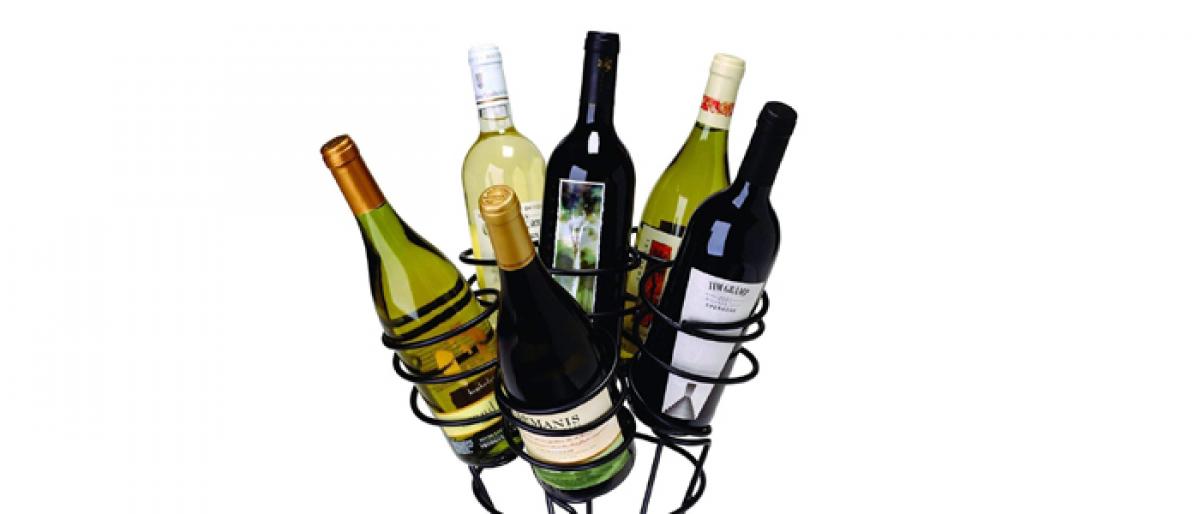Live
- Nizamabad MP Dharmapuri Arvind and Jagtial MLA Dr. Sanjay Kumar Meet CM Revanth Reddy
- Hyderabad CP CV Anand Issues Stern Warning to Bouncers
- MP Laxman Criticizes Police Conduct, Calls for Support for Victims' Families
- Fire Breaks Out in Kachiguda-Chennai Egmore Express, Passengers Evacuated Safely
- CM Revanth Reddy Condemns Attacks on Film Personalities' Homes, Calls for Strict Action
- Victory Venkatesh and Nandamuri Balakrishna to Set Screens on Fire with Unstoppable Season 4
- Over 71.81 crore Ayushman Bharat Health Account numbers generated: Centre
- In special gesture, Kuwait's Prime Minister sees-off PM Modi at airport after conclusion of historic visit
- Veer crowned PGTI Ranking champion, Shaurya wins emerging player honour
- Sr National Badminton: Unseeded Rounak Chauhan, Adarshini Shri reach singles semis
Just In

Wine is an unpretentious beverage and you can have it anytime and in any way Nonetheless, the finer aspects of wine can also be topics of discussion and debates Here are some tips to bring you up to date to the many talked about facets of wine
Wine is an unpretentious beverage and you can have it anytime and in any way. Nonetheless, the finer aspects of wine can also be topics of discussion and debates. Here are some tips to bring you up to date to the many talked about facets of wine.
The Wine Bouquet:
Wine aromas together form the bouquet of wine. They have been studied much in detail and have been categorised into different classes such as spicy, fruity to downright chemical and petroleum! There are many representations of various aromas in coloured wheels called aroma wheels. These are available online and are a cheat sheet for you during tasting. Nosing the wine is nothing but evaluating the various aromas of the wine.
However, don’t get intimidated as this is not an identification test. First smell the wine and place the aromas in broad categories such as floral if you identify type of flowers – like white or yellow, mild, intense or aromatic. In the fruity category look out for stone fruits – apple, peaches, cherries, plums or tropical fruits such as pineapple, mango, passion fruit, lychee, etc. Some grapes have signature aromas such as Sauvignon Blanc tending to have herbal aromas, grassy, gooseberry and other green fruit aromas. Wines on aging give aromas of leather, hay, meaty or gamey and sometimes chemical aromas such as petrol notes in the case of Riesling. Putting a name to the aromas will help you compare and discuss the wines while building up your wine vocabulary
Tastes and textures:
The sensation of wine on the tongue and in the mouth is referred to as the palate. The aromas are more often mirrored as flavours on the palate along with tastes of sweet, sour or bitter taste. These tastes vary in intensity from wine to wine. The warmth of alcohol is also felt along with astringency of tannins. The tannins also are of different types. They can be green and aggressive in young or simple wines; sometimes unbalanced or giving a sensation of dryness in the mouth and mellow, ripe or rounded as the wine ages.
The wines can be light, medium bodied or full bodied based on the weight of the wine on the palate. Thus, the sweetness and the acidity levels, type and level of tannins and the overall weight give a particular texture to the wine. For example, the fruity white wine ASAV Chenin Blanc is light with slight sweetness and well-balanced acidity with an overall rounded texture. Similarly, in reds, the spicy ASAV Shiraz is dry with mellow, rounded tannins and a medium to full body.
Wine Styles and Service:
The aromas, flavours and textures finally define the wine style, which in turn define how the wines need to be served. Lighter wines need to be chilled, with the whites and lowest tannin wines like sparkling wines to be served very chilled at around 6 to 8 degrees Celsius. Lightly tannic wines like rose wines can be served similar to most whites at 10 to 12 degrees Celsius. Lighter reds like Pinot Noir can be served at 14-16 degrees Celsius, while heavier reds can be served at 18-20 degrees Celsius.
The intensity of aromas further decides the shape of the stemware, a term used for the glasses used for wines. Light aromatic wines need tulip shaped glasses to push all the aromas to the nose. Reds need to open up and release some of the gases developed in the course of bottle aging. Hence lighter reds need slightly open and broader glasses while bigger and heavier reds taste best in open broad glasses. Sparkling wines look most beautiful as bubbles rise slowly in tall glasses called flutes.
Go ahead, bring out the wine, the glasses and talk about the wine, its aromas, tastes and textures and its style. Have a great conversation!
Ajoy Shaw - The writer is an Independent Consultant Winemaker and Wine Professional. He is also the consultant for Hyderabad-based Asav Wines.

© 2024 Hyderabad Media House Limited/The Hans India. All rights reserved. Powered by hocalwire.com







